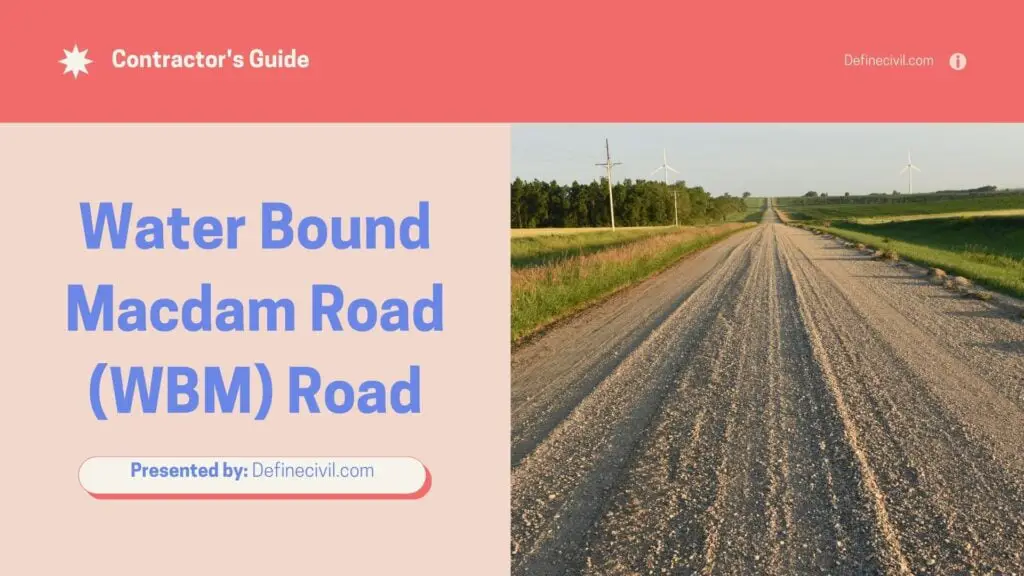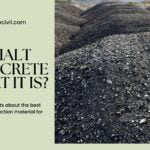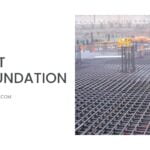Water bound Macadam roads are made of large broken stones bound together with tar and gravel to create a smooth, hard surface that holds up to car and truck traffic and isn’t as bumpy as other types of road surfaces.
Water bound macadam roads are made by laying down the stone bed and then covering it with the sand, gravel, and tar mixture, followed by another layer of stone and another layer of tar mixture.
It is called water-bound as no cementitious material like cement or asphalt is used. Instead, water helps the fine stone-dust to compact the broken stones.
Full form of WBM is water bound macadam. In a typical asphalt pavement, water-bound macadam acts as a base course layer. It can also go as a sub-base layer but it is not suitable as surfacing course for high volume roads.
Broken stones or aggregates are interlocked and filled with stone dust. Afterwards, water is applied and the road is left for compaction by vehicular traffic as well as by heavy smoothed wheel roller.
This article describes the process of building such a water-bound macadam road from start to finish, including how to construct and ensure the drainage on the road surface.
What is water bound macadam?
It is the type of road in which wearing course constitutes crushed aggregate that is interlocked mechanically by rolling, fine clay that is used as filler material, and the water that is sprinkled over the compacted base course, is known as water bound macadam (W.B.M) road.
Macadam surfaces are considered the gold standard of streets and highways due to their durability, longevity, and low maintenance costs.
There are different types of macadam surface, but one of the most prominent ones involves having water that’s been mixed with tar and other binders soaked into the existing pavement.
Strength of this road is totally depending upon mechanically interlocking of aggregates and presence of cohesion between aggregate particles due to moisture present in soil particles.
In this type of road only sand and clay constitute cementitious properties because of water sprinkled over it and no other cementitious material is used.
When high speed vehicles pass through this road, the slurry of sand and clay comes out and in result there is no binding force present in aggregate because of which aggregates get disintegrate and W.B.M road is destroyed.
Therefore, this type of road is only suitable for slow moving vehicles and not good for fast traffic.
Do you know who invented the water-bound macadam road?
Well, he was the Scottish engineer John Loudoun Macadam – who used and introduced this type of pavement. And the name water-bound macadam was also based on his name.

Aggregate Sizes
The thickness of the water-bound macadam base course or sub-base course depends a lot on the size and gradation of aggregate use. Here’re some specification and details of materials:
- The sizes of coarse aggregate we use are in grading range from 90 to 40 mm, 63 to 40 mm, or 50 to 20 mm.
- You need to pick mixture of hard and durable crushed aggregates and broken stones.
- It has to well-graded and should be free from elongated and flaky particles.
- You can follow a typical recommended range of aggregate gradation.
| Grading Number | Size Range in mm | Size of Sieve in mm | Percentage by Weight Passing the sieve |
| 1. | 90 to 40 | 100 80 63 40 20 |
100 65-85 25-60 0-15 0-5 |
| 2. | 63 to 40 | 80 63 50 40 20 |
100 90-100 35-70 0-15 0-5 |
| 3. | 50 to 20 | 63 50 40 20 10 |
100 95-100 35-70 0-10 0-5 |
You must evaluate the physical properties of the coarse aggregate like abrasion or impact resistance. I’ve summarized some standard test methods with recommended values of different layers of water-bound macadam for your reference:
| Sr. No. | Property | Requirement for Pavement Layer (maximum Percent) | ||
| Sub-base | Base course | Surfacing Course | ||
| 1. | Los Angeles Abrasion Value | 60 | 50 | 40 |
| 2. | Aggregate Impact Value | 50 | 40 | 30 |
| 3. | Flakiness Index | – | 15 | 15 |
Also Read: Median in a road – Types of medians -Raised
Screening or Filler Material
To fill the voids in coarse aggregate, we use finer aggregate that we call as screenings or filler material. It helps bound the interlocking of coarse aggregate.
Anyhow, the screening also has to be of suitable grading with standard percentages as per table below:
| Grading Classification | Size of Screenings (mm) | Sieve Size (mm) | Percentage by weight passing the sieve |
| A | 12.5 | 12.5
10.0 4.75 0.15 |
100
90-100 10-30 0-8 |
| B | 10.5 | 10.00
4.75 0.15 |
100
85-100 10-30 |
To reduce the overall cost of the road, IRC has recommended using non-plastic material. So, you use materials like Kankar nodules, murum, or gravel.
Binding Material
If you’re using gravel or murum for WBM road as screenings, you may not need a binding material. Anyhow, the binding material should be properly approved by the engineer and should have plasticity index value of less than 6.
Construction of W.B.M Road:
While this type of macadam road sounds fairly easy to build, it actually requires significant effort and expertise to make sure that it’s done right.
- Preparation of Sub-grade:
Preparation of sub-grade is the important component of road construction. It is prepared by compacting with the help rollers having weight 8 tons. Compaction by roller is not done in rocky areas.
- Construction of Sub-Base:
10 to 20cm sizes of Broken bricks, gravel, or stones are spread over sub-grade in the thickness of 15cm and 60cm wide which is then compacted by rollers to provide even surface.
- Construction of Base:
On the prepared sub-base or on directly over the sub-grade, specified material of base is spread and compacted for providing suitable base surface.
- Preparation of Wearing Course:
This course is laid in 2 or 3 layers with the thickness of each layer not more than 10cm. In this road wearing course consists of finer dust, clay and sand over which water is sprinkled and it acquires cementitious properties.
Also Read: Rigid Pavement – Difference between Rigid vs Flexible Pavement
Types of W.B.M Road:
It includes four types that are:
- Water Bound Macadam
- Traffic Bound Macadam
- Bituminous Bound Macadam
- Cement Macadam
Water Bound Macadam:
In this type, wearing course consists of stone dust and water that provide smooth surface and fills any type of gap present in aggregates.
Traffic Bound Macadam:
In this type, broken stones or gravels are used as wearing course. These stones and gravels are provided in multilayers whose thickness varies from 2.5 to 5.0 cm.
Bituminous Macadam:
In this type, bitumen is used as wearing course that binds aggregate or gravel and bind base and sub-base as well. This bituminous wearing course was adopted for avoiding dust related problems. It is modified form of flexible pavement.
Cementous Macadam:
In this type, cement is used as binding material instead of bituminous or clayey materials. This type is the modified form of rigid pavement.
Also Read: Rutting in Roads – Definition – Repair – Meaning – Causes
Advantages of W.B.M Road:
Macadam road consists of following advantages:
- It comprises lower construction cost as compared to other roads.
- It is easy to construct and maintain as compared to other roads.
- No expertise is required for construction of this type of road.
Disadvantages of W.B.M Road:
WBM road comprises following disadvantages:
- It is employed for low traffic capacity.
- During rainfall reason, it becomes difficult to use it.
- It consists inferior riding qualities.
Also Read: Road Drainage- Purpose – function-Types-Advantages-Disadvantages



















